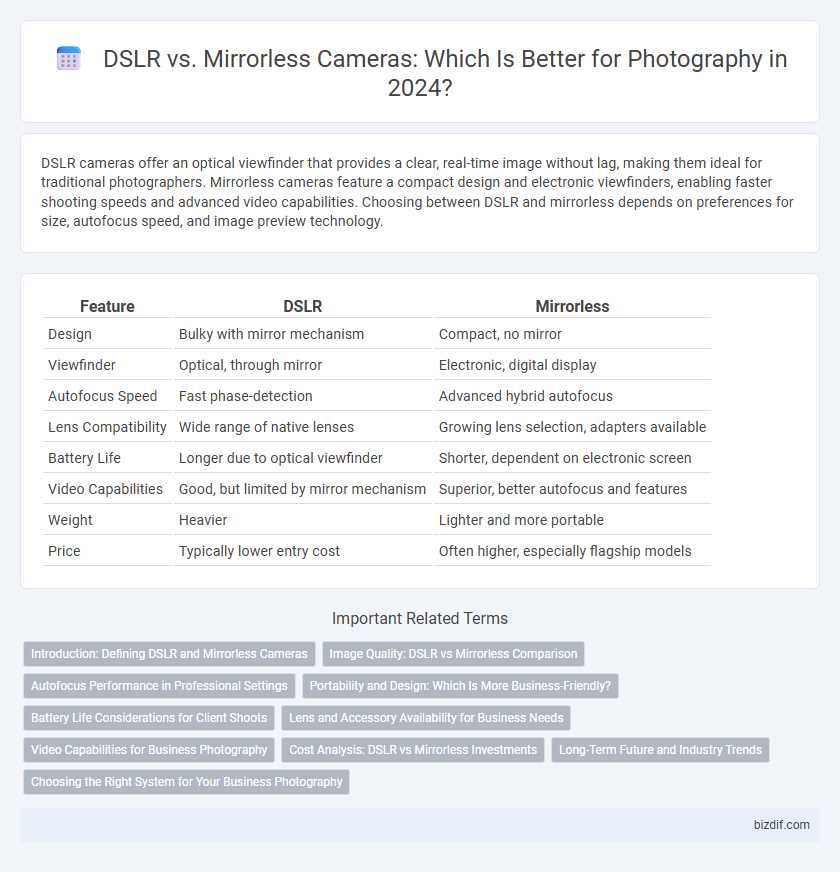DSLR cameras offer an optical viewfinder that provides a clear, real-time image without lag, making them ideal for traditional photographers. Mirrorless cameras feature a compact design and electronic viewfinders, enabling faster shooting speeds and advanced video capabilities. Choosing between DSLR and mirrorless depends on preferences for size, autofocus speed, and image preview technology.
Table of Comparison
| Feature | DSLR | Mirrorless |
|---|---|---|
| Design | Bulky with mirror mechanism | Compact, no mirror |
| Viewfinder | Optical, through mirror | Electronic, digital display |
| Autofocus Speed | Fast phase-detection | Advanced hybrid autofocus |
| Lens Compatibility | Wide range of native lenses | Growing lens selection, adapters available |
| Battery Life | Longer due to optical viewfinder | Shorter, dependent on electronic screen |
| Video Capabilities | Good, but limited by mirror mechanism | Superior, better autofocus and features |
| Weight | Heavier | Lighter and more portable |
| Price | Typically lower entry cost | Often higher, especially flagship models |
Introduction: Defining DSLR and Mirrorless Cameras
DSLR cameras use a mirror mechanism to direct light from the lens to an optical viewfinder, providing a traditional shooting experience with interchangeable lenses and robust battery life. Mirrorless cameras eliminate the mirror, relying on electronic viewfinders or LCD screens for composing images, offering compact designs and faster continuous shooting speeds. Both camera types support high-resolution sensors and advanced autofocus systems, catering to various photography styles and professional needs.
Image Quality: DSLR vs Mirrorless Comparison
DSLR cameras traditionally use a mirror mechanism to direct light to an optical viewfinder, providing accurate color rendition and dynamic range, while mirrorless cameras offer enhanced sensor performance with advanced autofocus systems and improved in-body image stabilization. Mirrorless models often deliver superior image quality in low-light conditions due to cutting-edge sensor technology and on-sensor phase detection, surpassing many DSLRs. High-resolution sensors and real-time electronic viewfinders in mirrorless cameras enable more precise exposure control, resulting in sharper, more detailed images compared to comparable DSLR models.
Autofocus Performance in Professional Settings
Mirrorless cameras typically offer superior autofocus performance in professional settings due to advanced on-sensor phase-detection pixels, enabling faster and more accurate subject tracking compared to most DSLRs. Professional photographers benefit from mirrorless systems' ability to maintain continuous autofocus during video recording and use eye-tracking focus modes for portraits. While high-end DSLRs possess reliable autofocus, mirrorless technology continues to lead in speed and precision crucial for dynamic shooting environments.
Portability and Design: Which Is More Business-Friendly?
Mirrorless cameras offer superior portability and compact design compared to DSLRs, making them ideal for business professionals who require lightweight, easy-to-carry gear. Their reduced size and weight enable longer shooting sessions without fatigue, boosting productivity in dynamic work environments. This slim profile also contributes to discreet shooting, which is valuable for event photographers and corporate settings.
Battery Life Considerations for Client Shoots
DSLR cameras generally offer longer battery life than mirrorless models, making them more reliable for extended client shoots without frequent recharging. Mirrorless cameras, while providing advantages like compact size and faster autofocus, often require carrying extra batteries to avoid interruptions during sessions. Photographers should evaluate shoot duration and power management options to ensure consistent performance and client satisfaction.
Lens and Accessory Availability for Business Needs
DSLR cameras offer a wider selection of lenses and accessories due to their longer market presence, making them ideal for businesses requiring diverse shooting options and specialized gear. Mirrorless systems are rapidly expanding their lens lineups and accessory compatibility, providing more lightweight and compact alternatives without compromising professional quality. Evaluating lens variety and accessory support is crucial for businesses prioritizing adaptability and future-proof investment in photography equipment.
Video Capabilities for Business Photography
Mirrorless cameras excel over DSLRs in video capabilities due to advanced autofocus systems, higher frame rates, and superior in-body image stabilization, making them ideal for business photography requiring dynamic video content. Their compact design and electronic viewfinders provide precise exposure previews and flexibility in various shooting environments, enhancing video production quality. Businesses benefit from mirrorless technology by producing professional-grade videos with better low-light performance and faster processing speeds, essential for marketing and promotional materials.
Cost Analysis: DSLR vs Mirrorless Investments
DSLR cameras typically require higher initial investments due to larger, more complex bodies and extensive lens libraries, but often offer greater compatibility with third-party accessories, potentially lowering long-term costs. Mirrorless cameras, while generally priced higher upfront because of advanced sensor technologies and electronic viewfinders, provide savings through lighter, more compact designs that reduce accessory expenses and improve portability. Evaluating total cost of ownership for both DSLR and mirrorless systems involves considering not only initial purchase prices but also lens availability, maintenance, and future upgrade potential.
Long-Term Future and Industry Trends
Mirrorless cameras are rapidly surpassing DSLRs in market share due to advancements in sensor technology, autofocus speed, and video capabilities. Industry trends show manufacturers investing heavily in mirrorless systems, with major brands like Canon, Nikon, and Sony phasing out new DSLR models. The long-term future favors mirrorless cameras as innovation centers on compact design, electronic viewfinders, and seamless connectivity for professional and enthusiast photographers.
Choosing the Right System for Your Business Photography
DSLR cameras offer robust build quality, extensive lens selections, and longer battery life, making them ideal for traditional business photography needs. Mirrorless systems provide faster autofocus, lighter designs, and superior video capabilities, catering to dynamic, on-the-go shoots. Assessing your business's specific demands, such as image quality, workflow efficiency, and client deliverables, will guide the optimal choice between DSLR and mirrorless cameras.
DSLR vs Mirrorless Infographic

 bizdif.com
bizdif.com